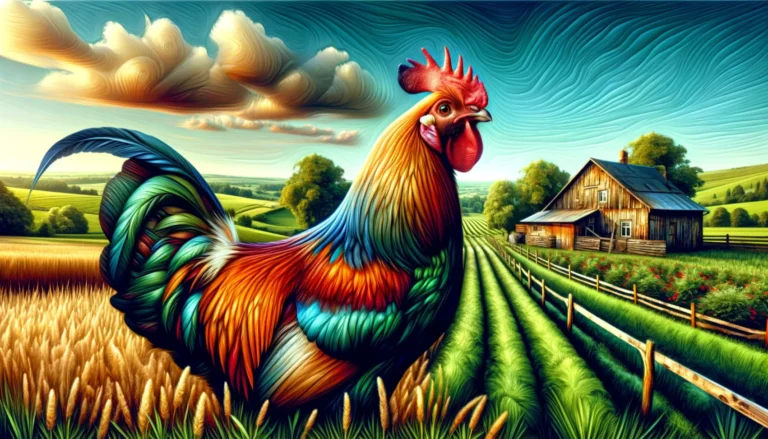The Captivating Onagadori: Chicken Symbolism and Meaning

The Onagadori is truly one of the most unique chicken breeds in the world. Originating in Japan, these chickens are best known for their extraordinarily long tails and spiritual symbolism. In this blog post, we’ll explore the mystical legends and symbolic meaning behind the Onagadori chicken.
An Ancient Breed with Regal Bearing
- Onagadori translates to “honorable fowl” in Japanese
- One of the oldest chicken breeds, originating over 400 years ago in Japan
- Prized for their regal bearing and extraordinarily long tail feathers
- Tails can grow over 10 feet long, the longest of any chicken breed
The Onagadori is an ancient Japanese breed regarded as a national treasure in its native land. “Onagadori” translates to “honorable fowl,” reflecting the reverence these chickens are accorded.
With their upright posture, flowing tail feathers trailing grandly behind them, and elegant bearing, they fully embody their noble moniker. Their signature tails, which cascade nearly to the ground in captivating fashion, can reach over 10 feet long – the longest tails of any chicken breed in the world.
Spiritual Legends and Meaning
- Mythology states their long tails symbolize luck and prosperity
- Believed the longer the tail, the more good fortune they bring
- Historically presented as gifts to honor deities and nobles
- Remain important in spiritual customs and folklore today
These chickens have special significance in Japanese culture, mythology, and spiritual traditions. Their extraordinarily long tails are believed to symbolize luck, prosperity, and divine blessing.
According to legend, the longer an Onagadori’s tail flows, the more good fortune they bring to their caretakers. With tails sometimes trailing over 10 feet behind these regal birds, they were regarded as particularly promising omens.
So strong is this symbolic meaning that Onagadori were historically presented as honored gifts to nobles, temples, and shrines. They remain important in some spiritual customs and folklore today.
Natural Monument Status
- Declared a Natural Monument of Japan in 1952
- Protected status for cultural heritage and rarity
- The population was endangered but now increasing again
- Concerted efforts to preserve the breed’s lineage
In 1952, the Onagadori was officially declared a Natural Monument of Japan, receiving protected status as a national treasure. This designation recognizes the cultural heritage and rarity inherent in the breed.
After years of declining numbers, the population has been rebounding thanks to conservation efforts. Breeders and preservation societies are actively working to keep the Onagadori bloodline enduring for generations to come.
Symbol of Luck, Nobility, and Prosperity
In summary, the Onagadori chicken holds deep symbolic meaning in its native Japan and beyond. With its regal bearing, spiritual legends, and protected status, the “honorable fowl” is an emblem of luck, nobility, prosperity, and divine blessing.
The Onagadori’s extraordinarily long, flowing tail feathers represent good fortune and the bird’s power to impart blessings. As a Natural Monument and important cultural heritage breed, efforts continue to preserve the captivating Onagadori for the future.
Key Takeaways
- Ancient Japanese chicken breed prized for 10+ foot long tail feathers
- The name “Onagadori” means “honorable fowl”
- Mythology states long tails bring luck, prosperity, and blessings
- Historically gifted to honor deities and nobles
- Declared a protected Natural Monument of Japan in 1952
- Symbol of luck, nobility, prosperity, and divine favor
The mystical Onagadori, with its elegant bearing and spiritual legends, will surely continue to enter chicken aficionados and culture enthusiasts alike for generations to come. With tails trailing dramatically behind them as they strut proudly along, these Japanese “honorable fowl” fully live up to their regal repute.
FAQ
1. What is the Onagadori chicken breed known for?
The Onagadori chicken breed is known for its long, flowing tail feathers and beautiful plumage. It is also recognized for its friendly personality, making it a great choice for both pet owners and those seeking eggs from their flock.
Where did the Onagadori chicken breed originate?
The Onagadori chicken breed originated in the province of Nagoya, Japan during the Edo period. It was particularly popular among landowners and samurai, who considered the elegant tails of these chickens to symbolize status and wealth.
What do Onagadori chickens look like?
Onagadori chickens have extremely long tail feathers, with an average length of at least four feet. Some individuals may even have tails that reach six or seven feet in length. They come in various colors, including red, black, white, blue, and green.
Do Onagadori chickens lay many eggs?
No, Onagadori chickens are not prolific layers. On average, they lay around 100 eggs per year, which translates to approximately two to three eggs per week. They are not the best choice for those primarily seeking high egg production.
Can Onagadori chickens be raised for meat?
While Onagadori chickens can be consumed as meat, they are not ideal for commercial meat production. They take longer to reach maturity compared to other breeds and have relatively small bodies. However, if raised with patience, their lean and flavorful meat can be enjoyed on the dinner table.





